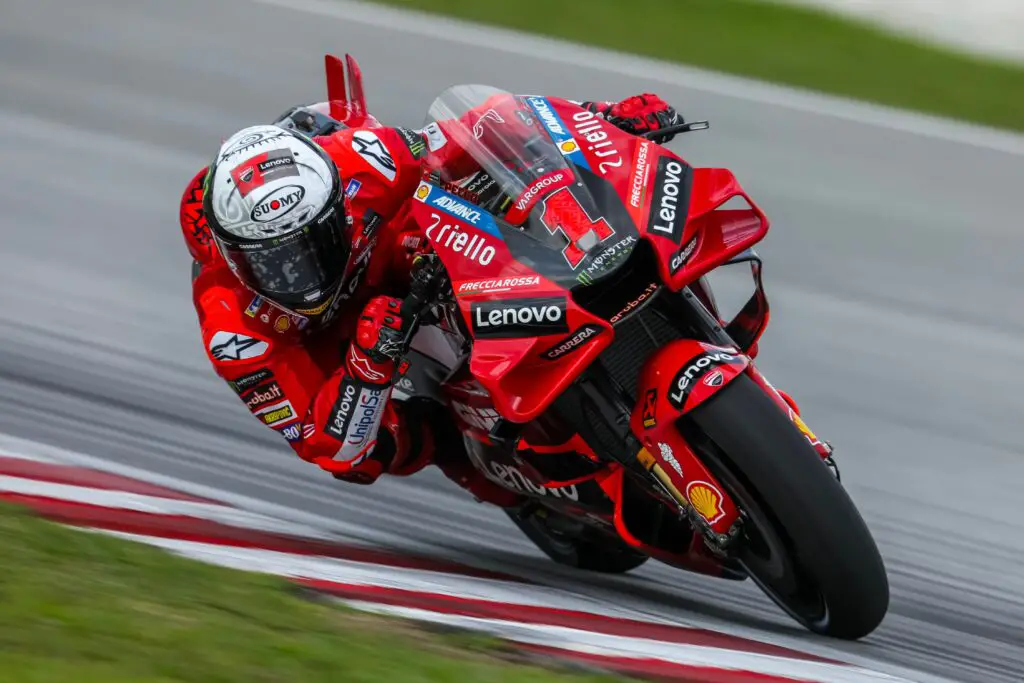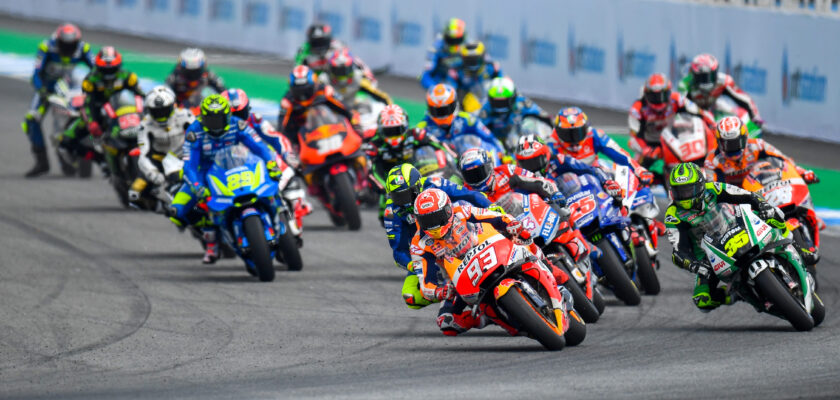With a history of more than 70 years, MotoGP stands out as the world’s leading motorcycle racing category. For this reason, it attracts a legion of passionate fans around the globe. In addition, you’ll discover more about the rules of the category and the scoring system, which races are contested throughout the season and who the racers are. Don’t waste any more time and find out everything about MotoGP now!

Open your Betano account and get up to 1,000 reais in bonuses.
Payments via PIX, live games and super odds!
Click here to open your account!
All about MotoGP: the origins of the sport
The MotoGP competition is the oldest among motor sports, having started its first season in 1949, when Briton Leslie Graham won the title;
At the time, the category was known as 500cc, referring to the displacement of the participating motorcycles.
Over the years, MotoGP has evolved and is currently made up of three exciting categories: MotoGP, Moto2 and Moto3.
MotoGP is the main category, where riders face extreme challenges in pursuit of ultimate glory. The Moto2 replaced the old 250cc category, while the Moto3 is the successor to the old 125cc category.
Since 2019, the championship has also featured MotoE, a revolutionary category that uses high-performance electric motorcycles;
This new category reflects MotoGP’s commitment to embracing sustainable technology and promoting innovation in the world of motorcycle racing.
Continue reading all about everything MotoGP!
All about MotoGP: rules and regulations
The starting grid in a MotoGP race is made up of three columns. Similar to the main categories in motorsport, the starting positions are determined by the fastest laps in qualifying.
The races are run from start to finish without pit stops for tire changes and refueling.
If it rains during the race, a white flag is triggered and riders can go to the pits to change bikes;
They must use identical bikes to the ones they were riding, but equipped with different tires, such as intermediates or wet tires, instead of slicks. Even 15th place earns points in a MotoGP race;
See below how the category’s scoring system works:
- 1st – 25 points
- 2nd – 20 points
- 3rd – 16 points
- 4th – 13 points
- 5th – 11 points
- 6th – 10 points
- 7th – 9 points
- 8th – 8 points
- 9th – 7 points
- 10th – 6 points
- 11th – 5 points
- 12th – 4 points
- 13th – 3 points
- 14th – 2 points
- 15th – 1 point
Continue reading everything about MotoGP!
All about MotoGP: the circuits
In total, the MotoGP championship has 21 circuits that challenge riders to give their best in each race:
- Qatar Grand Prix (Losail International Circuit)
- Portuguese Grand Prix (Algarve’s International Racetrack)
- GP of the Americas (Circuit of the Americas)
- Spanish Grand Prix (Jerez’s Permanent Circuit)
- French Grand Prix (Bugatti Circuit)
- Catalonia Grand Prix (Catalonia’s Circuit)
- Italian Grand Prix (Mugello Circuit)
- Kazakhstan Grand Prix (Sokol International Racetrack)
- Dutch Grand Prix (TT Circuit Assen)
- German Grand Prix (Sachsenring)
- British Grand Prix (Silverstone)
- Austrian Grand Prix (Red Bull Ring)
- Aragon Grand Prix (MotorLand Aragão)
- San Marino Grand Prix (Misano World Circuit Marco Simoncelli)
- Indian Grand Prix (Buddah International Circuit)
- Indonesian Grand Prix (Mandalika International Street Circuit)
- Japanese Grand Prix (Mobility Resort Motegi)
- Australian Grand Prix (Phillip Island Grand Prix Circuit)
- Thailand Grand Prix (Chang International Circuit)
- Malaysian Grand Prix (Sepang International Circuit)
- Valencia GP (Circuit Ricardo Tormo)
Continue reading everything about MotoGP!
All about MotoGP: current riders and teams
MotoGP currently has 22 riders in 11 teams:
Aprilia Racing
- Maverick Viñales (Spain)
- Aleix Espargaró (Spain)
Ducati Team
- Francesco Bagnaia (Italy)
- Enea Bastianini (Italy)
Gresini Racing
- Alex Márquez (Spain)
- Marc Márquez (Spain)
LCR Honda
- Johann Zarco (France)
- Takaaki Nakagami (Japão)
Monster Energy Yamaha MotoGP
- Fabio Quartararo (France)
- Álex Rins (Spain)
Pertamina Enduro VR46 Racing Team
- Fabio Di Giannatonio (Italy)
- Marco Bezzecchi (Italy)
Prima Pramac Racing
- Franco Morbidelli (Italy)
- Jorge Martin (Spain)
Red Bull KTM Factory Racing
- Brad Binder (South Africa)
- Jack Miller (Australia)
Repsol Honda Team
- Luca Marini (Italy)
- Joan Mir (Spain)
Trackhouse Racing MotoGP
- Raul Fernandez (Spain)
- Miguel Oliveira (Portugal)
Red Bull GasGas Tech3
- Pedro Acosta (Spain)
- Augusto Fernandez (Spain)
Continue reading everything about MotoGP!
All about MotoGP: the best riders of all time
MotoGP has always been the scene of great rivalries and exceptional talent. Over the years, some riders have stood out, winning multiple titles and leaving their legacy in the competition. Among MotoGP’s greatest champions are:
- Giacomo Agostini: 8 titles
- Valentino Rossi: 7 titles
- Marc Márquez: 6 titles
- Michael Doohan: 5 titles
- Mike Hailwood, John Surtees, Geoff Duke e Eddie Lawson: 4 titles each
These legendary riders have marked the history of MotoGP, demonstrating skill, courage and determination to achieve excellence on two wheels.
Continue reading all about MotoGP!
All about MotoGP: advances and news
MotoGP has evolved continuously since its creation in 1949, adopting new technologies, changing regulations and expanding its categories. Here are some of the main advances and novelties over the years:
1940s and 1950s
- 1949: the inauguration of the Motorcycle World Championship, with the main class being the 500cc.
- 1950s: introduction of manufacturers such as MV Agusta and Gilera, who dominated the decade.
1960s and 1970s
- 1960s: the arrival of new manufacturers, including Honda and Yamaha, which brought significant innovations in terms of technology and performance.
- 1966: the introduction of two-stroke engines, which became popular in the smaller classes.
- 1970s: consolidation of the dominance of two-stroke engines in the smaller categories and greater focus on rider safety.
Continue reading all about everything MotoGP!
1980s and 1990s
- 1980s: increased use of more advanced suspension and braking technology.
- 1988: introduction of the modern scoring system, with the aim of making the championship more competitive.
- 1990s: development of advanced electronics and traction control systems.
The 2000s
- 2002: name change from 500cc to MotoGP, with the introduction of four-stroke engines of up to 990cc, marking a new era in competition.
- 2004: introduction of more sophisticated electronic controls, including traction control.
- 2007: engine capacity reduced to 800cc to increase rider safety.
- 2009: introduction of the single engine for the Moto2 class, using 600cc Honda engines.
Years 2010
- 2012: increasing the capacity of the MotoGP engine to 1000cc, providing more power and performance.
- 2014: introduction of the Open class, allowing greater development freedom for smaller teams.
- 2016: introduction of a standardized ECU for all teams to reduce costs and level the playing field.
- 2019: inauguration of the MotoE category, with high-performance electric motorcycles, reflecting MotoGP’s commitment to sustainability and innovation.
2020
- 2020: implementation of new health and safety protocols due to the COVID-19 pandemic, including closed races and reduced timetables.
- 2021: expansion of the use of advanced aerodynamic technologies, such as wings and airflow control devices.
- 2022: introduction of new technical regulations to limit the amount of testing and development during the season, in order to reduce costs.
- 2023: increased focus on sustainability, with initiatives to reduce the championship’s carbon footprint and greater use of biofuels.
Continue reading all about MotoGP!
Latest technical innovations
- Telemetry and Big Data: extensive use of real-time data and analysis to improve motorcycle performance and racing strategy.
- Advanced materials: development of new materials to reduce weight and increase the resistance of motorcycles.
- Safety: constant improvements to riders’ protective suits, including integrated airbags and safer helmets.
These advances and innovations have contributed to making MotoGP one of the most exciting and technically advanced competitions in the world of motorsport.
Are you into speed sports and want to know more about them? Read also:



